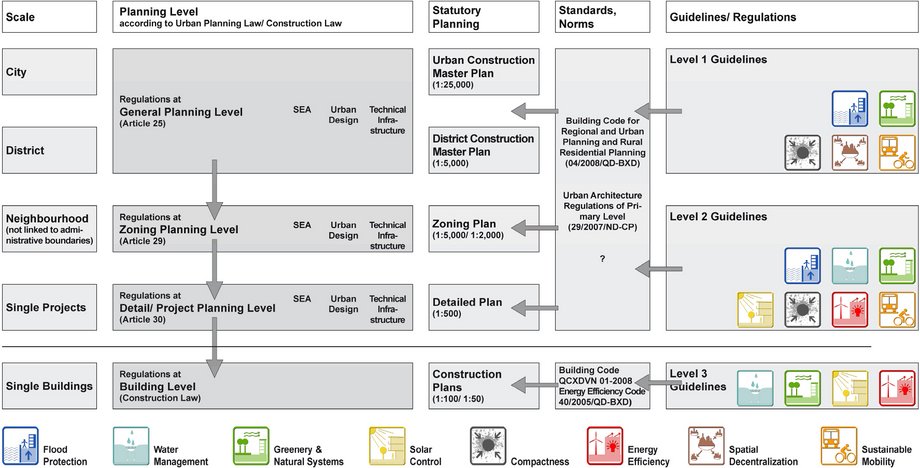Planning and Design Guidelines
More frequent and severe environmental hazards in HCMC have raised awareness of climate change, particularly of flooding. Urban development is viewed as the major cause rather than climate change. In this context, urban planning is considered to be a key element for the city’s adaptation to these environmental and climate change threats. The urban form is the most apparent part of an unsustainable urban development. However, while research on the environmental aspect of climate change impacts has been initiated, approaches for the integration of adaptation options into the current urban design and the current urban planning processes are still lacking and, thus, needed.
As “Guideline” component, methods for regulating the urban design were elaborated. WP 7 raised the question, if urban planning and design guidelines could serve as instrument to steer urban development. According to HCMC’s Planning Decree 29 the Department of Planning and Architecture (DPA) issued directives for a small inner-city area for the first time in Vietnam. These guidelines regulate a mere of dimensions related to the urban form, but exceed national building codes and specifications from urban development plans. However, there is mutual consent, that this method is suitable for further regulations.
The Construction and the Urban Planning Law define the main spatial planning levels, the related statutory plans and their content. Detailed specifications are noted in additional standards and codes. However, while at the building level binding standards like the Building Code exist, the levels of general and zoning planning are lacking effective regulations. In particular the amendment of the Urban Planning Law in June 2009 introduced the level of zoning, but without the formulation of respective specifications. Further, this law demands strategic environmental assessments (SEA) as well as declarations to the urban design and the technical infrastructure as inherent part of each planning level. Even there, specifications are lacking, yet. Therefore, the elaboration of these standards may serve as a platform for implementing additional regulations in terms of climate change adaptation and energy efficiency.
The main result of the research consists of two products: a set of guidelines as checklist for plan approval procedures and a handbook explaining different strategies to integrate urban climate and urban flooding concern in urban design and planning which will be handed out to HCMC planning institutions and authorities, such as the HCMC Department of Planning and Architecture.
Both documents should
- assist HCMC’s planning authorities in establishing binding and non-binding climate change adapted urban planning and urban design codes/recommendations
- promote a climate change adapted urban planning as well as urban design measures to private investors, private developers, architects and urban designers
The main approach is the downscaling of general HCMC-related climate change adaptation strategies into specific climate change adapted urban planning and urban design guidelines through different components of climate change such as urban heat, surface water, flood risk and urban mobility. Solutions are specified, based on local spatial and economical characteristics. The proposed solutions are tested through two specific case studies in order to reveal their possible transferability and specifications. The case studies are real on-going development projects located in representative urbanised areas of HCMC. Both were chosen in agreement with the planning authorities of HCMC.

